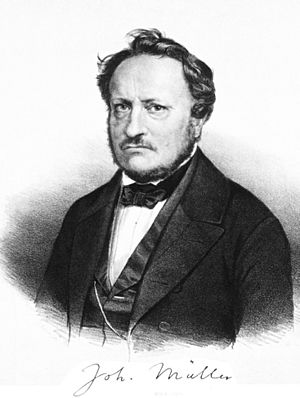Johannes Müller facts for kids
Quick facts for kids
Johannes Peter Müller
|
|
|---|---|

Johannes Peter Müller
|
|
| Born | 14 July 1801 |
| Died | 28 April 1858 (aged 56) |
| Nationality | Germany |
| Alma mater | Bonn University |
| Scientific career | |
| Fields | Physiology |
| Doctoral advisor | Philipp Franz von Walther Karl Rudolphi |
| Doctoral students | Hermann von Helmholtz Rudolf Virchow |
| Influenced | Charles Scott Sherrington |
Johannes Peter Müller (born July 14, 1801 – died April 28, 1858) was an important German scientist. He was a physiologist, which means he studied how living things work. He also studied comparative anatomy, looking at how different animals are built. Müller was an expert in ichthyology (fish) and herpetology (reptiles and amphibians). In 1833, he became a professor of physiology at the University of Berlin.
Contents
Who Was Johannes Peter Müller?
Johannes Peter Müller was born in Koblenz, Germany. He grew up to be one of the most famous scientists of his time. He was known for his wide range of interests. He studied many different areas of biology and medicine.
Early Life and Education
Müller started his studies at Bonn University. He learned a lot from his teachers, Philipp Franz von Walther and Karl Rudolphi. These early studies helped him become a great scientist. He was very curious about how the body works.
Müller's Work in Physiology
Müller's main field was physiology. This science looks at how organs and systems in the body function. He wrote a very important book called Handbuch der Physiologie des Menschen. This book was about human physiology. It helped many other scientists understand the human body better.
Exploring Animal Life
Later in his life, Müller spent a lot of time studying animals. He was especially interested in how different animals are built. This is called comparative anatomy.
Studying Fish and Sea Creatures
Müller loved to study fish and other animals that live in the ocean. He took many trips to the sea. He visited the Baltic Sea, the North Sea, the Adriatic Sea, and the Mediterranean Sea. He wanted to learn all about the creatures living in salt water. He made 19 trips just to study marine life.
Research on Amphibians and Reptiles
Müller also wrote a big book about amphibians. In his time, this group included reptiles too. He described many new kinds of snakes. His work helped people understand these animals much better.
Mentoring Future Scientists
Johannes Peter Müller was not just a great scientist himself. He also taught and guided many students who became famous.
Famous Students of Müller
Some of his most well-known students include:
- Hermann von Helmholtz: A brilliant scientist who made discoveries in physics and physiology.
- Emil du Bois-Reymond: A pioneer in studying electricity in muscles and nerves.
- Theodor Schwann: Known for his work on cells and the cell theory.
- Rudolf Virchow: A very important doctor who studied diseases.
- Ernst Haeckel: A biologist who studied evolution and ecology.
These students carried on Müller's legacy. They made many new discoveries in science.
Awards and Recognition
Müller's important work was recognized by many groups.
- In 1834, he became a foreign member of the Royal Swedish Academy of Sciences.
- In 1854, he received the Copley Medal from the Royal Society in London. This is one of the oldest and most important science awards.
See also
 In Spanish: Johannes Müller para niños
In Spanish: Johannes Müller para niños

